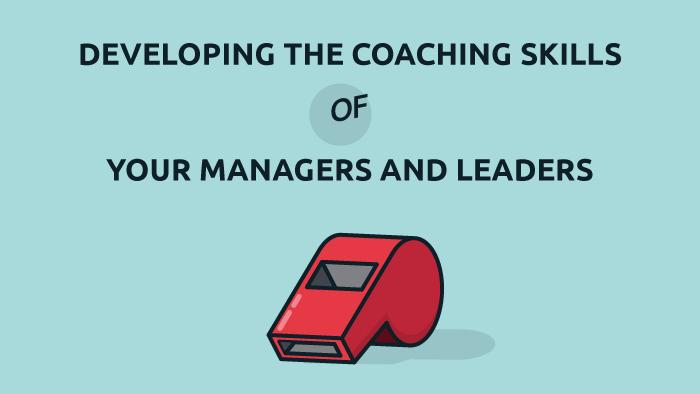There are several leadership skills and competencies leaders must embody in today’s workplace, but what is the secret to improving the performance of your entire workforce? One word: Coaching.
Managers and leaders are the driving force that ensures a business’s success, and it’s no secret that effective coaching skills play an instrumental role in this. Coaching your employees consistently can help them improve their performance, acquire new skills, and foster knowledge transfer.
The coaching management style is gaining traction over the authoritarian style, as leaders focus more on developing the skills and abilities of their team members. This leads to increased engagement, productivity, and innovation, which will help businesses achieve sustainable growth.
If you’re building a training program for new managers, developing coaching skills should definitely be a priority!
How to Coach Employees at Different Levels
Successful coaching can be easy to spot – but recreating its success can be a difficult task.
Before we get to our seven coaching tips, here’s a quick example of how you can align coaching conversations with individual employees’ needs.
First and foremost, it’s crucial to understand that there’s no one-size-fits-all approach when it comes to employee coaching. Every employee has their strengths, weaknesses, and unique needs – so it’s essential to tailor your approach to each individual. To ensure that you’re providing the right kind of feedback to your team, you need to assess where they’re at in their job role and career. This helps you meet them where they are and understand where they need the most help.
To coach your learners effectively, you’ll need to adapt your coaching management style to match their level of performance. Here are the FIVE levels of employee performance:
- Novices
- Doers
- Performers
- Professional
- Experts
Level 1: Novice
Novices need a lot of instruction and correction. They’re in the “telling” stage of learning, where they need to be shown what to do. If you’re confident in your hires, they won’t need to stay in this stage for long. But be careful not to micromanage them—you don’t want to hold them back from moving to the next level!
Level 2: Doer
Once novices start to understand the task and perform, they transition to the doer stage. They still need a lot of instruction and correction, but they’re also starting to contribute to the team. This is a great time to encourage new behaviors and praise them for their good results. Remember, the goal is to help doers move to the “independent” stage of learning, where they can work with minimal guidance. With your support, they’ll be on their way to becoming experts in no time!
Level 3: Performer
When doers start accomplishing tasks to standards, they become performers. They’re now doing real work and carrying their full share of the load. They’re also doing the task the way it should be done. With performers, there’s much less “tell” coaching, if any at all. But there’s still feedback, mostly focused on recognizing good results and improving the results that don’t meet expectations.
Level 4: Professional
Some performers may continue to grow on the job and reach the professional stage. At this point, they can not only accomplish tasks to standards, but they can do so efficiently and effectively. They also have a deep enough understanding of what should be done, they can now teach and coach others.
Level 5: Expert
Experts are valuable members of the team and may become front-line team leads. Experts don’t need a lot of direction – they’re highly self-sufficient. If anything, they can provide direction to others. Experts don’t necessarily require a lot of recognition and praise to stay motivated, but that doesn’t mean they don’t want any!
Inspire your workforce with our 7 COACHING TIPS: FROM MANAGER TO COACH!
7 Coaching Tips for Your Managers and Leaders
Now that we’ve gone over the different performance levels your employees can be at, let’s get to the good stuff — the tips!
These coaching tips will work with any of those five levels and can help your managers have more mutually beneficial coaching conversations that will improve overall team performance!
1. Asking guiding questions
Open-ended, guiding questions lead to more detailed and thoughtful answers, which lead to more productive coaching conversations in the workplace. As a manager or leader, it is critical that you develop strong relationships with your employees. This will help you determine if your employees are curious, have the capacity to perform and improve, and what kind of attitude they have toward their work.
This is where communication skills and emotional intelligence really come into play. Managers must guide conversations both by asking questions and listening, not by giving directives. Employees learn and grow the most when they uncover the answers themselves, making the techniques of coaching highly effective.
2. Recognizing what’s going well
Coaching (successfully) in the workplace requires a balance of criticism and praise. If your coaching conversations solely focus on identifying what’s not working and how the employee needs to change, it can be demoralizing rather than motivating.
Recognizing and valuing an employee’s strengths can provide a solid basis for growth and development. However, it’s important to avoid using the “compliment sandwich” approach, as it can often come across as disingenuous and lacking in authenticity.
Instead, take the time to genuinely recognize specific areas where the employee excels and let them know that their efforts are valued. Additionally, it’s important to consider how the employee prefers to be recognized. Some individuals thrive with frequent recognition, while others find occasional acknowledgment sufficient. Understanding their preferences, whether they prefer public or private recognition, is crucial in fostering a positive coaching management style. Openly communicate with your employees and ask about their preferred coaching techniques and examples of effective coaching in the workplace.
3. Listening and empowering
Coaching requires both encouragement and empowerment. As a manager and a leader, your job is to build one-on-one relationships with employees that result in improved performance.
Your employees are likely to have a lot of input, questions, and feedback. It’s important for them to know you care enough to listen to what they have to say, so encourage them to share their opinions.
Some employees will have no problem speaking their mind, while others will need a LOT of encouragement before they share an opinion with you openly. Once they do open up, be sure to respect those opinions by discussing them, rather than dismissing them.
4. Understanding their perspective
When you’re coaching employees to improve performance and engagement in the workplace, adopting a coaching management style is crucial. It involves approaching things from their perspective, understanding their motivations, preferences, and personalities. By asking questions, you can uncover their “why” and their preferred “how,” enabling you to tailor coaching conversations that align with their individual working style and the desired improvements.
Coaching in the workplace example: Let’s say you recently transitioned to a more open office plan, and one of your sales team reps has experienced a significant decline in successful calls. Through open-ended questioning, you discover that this individual excels in one-on-one conversations but struggles to speak up in a group setting. Understanding that they feel uncomfortable with everyone listening in on their calls, you can work with them more effectively to regain their confidence and improve their numbers.
With their perspective in mind, you can work with them more effectively on how to get them back on target.
5. Talking about the next steps
Coaching conversations in the workplace are meant to yield changes and results, so be sure to clearly define and outline what needs to happen next. This will ensure you and your employees are on the same page with expectations and provide them with a clear understanding of the practical steps they can take to make changes and improve.
Also, these next steps should be mutually agreed upon – talk about what is reasonable to expect given their workload and the complexity of the changes being made.
6. Coaching in the moment
If an employee comes to you with a question about a process or protocol, use this opportunity to teach them something new. If you are unable to immediately address their concerns, schedule the time as soon as possible to go over it.
Better yet, maintain a weekly one-on-one meeting with each employee to regularly discuss questions and issues, while prioritizing productivity. Coaching employees with the goal of improving performance means making them a priority each week! By practicing frequently, you’re able to hone your coaching management style and feel more comfortable giving feedback in the moment instead of just as scheduled times.
Demonstrate that you genuinely care about your employees’ professional success, utilizing effective coaching management style techniques in the workplace. Coaching is often thought of as a corrective measure, however, coaching can also be a valuable tool for career development conversations – so don’t wait. By providing employees with the opportunity to reflect on their goals, skills, and experiences, coaches can help them to identify new opportunities and make informed decisions about their future.
After all, you don’t just want them to do better so you look better – show them you’re actively interested in their career, accomplishments, and professional success.
7. Committing to continuous learning
Make a commitment to improve your own skills and competencies in the workplace.
If you want your employees to continuously learn and grow, lead by example.
Show a genuine interest in their success (why wouldn’t you be?) and ask questions about where they see their career going, or how they envision their role evolving in the company. Even if they haven’t laid out a plan yet, these questions will prompt them to think about their career and what they hope to achieve within your organization.
Upskilling and reskilling your employees is a great way to show them that you value their development and that you are committed to their success. By investing in your employees’ skills, you are investing in the future of your organization. According to Training Magazine, 57% of U.S. workers want to update their skills, and 48% would consider switching jobs to do it.


